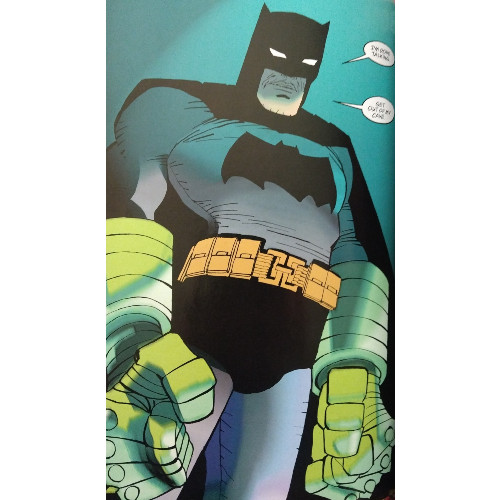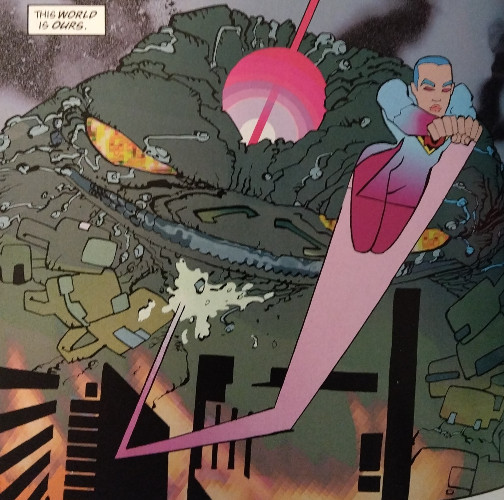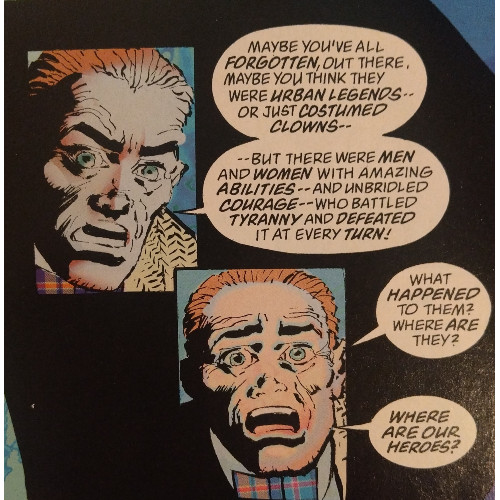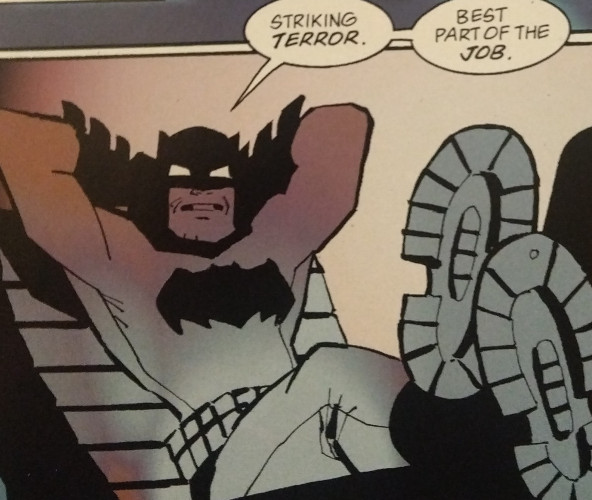Distinguished Critique: Batman: The Dark Knight Strikes Again Review
The sequel to Frank Miller's magnum opus is a disappointing blend of garish visuals, lifeless characters, and brash theming
—by Nathan on November 23, 2024—

Fifteen years after creating the quintessential Batman story in The Dark Knight Returns, Frank Miller returned to Gotham City. He returned to Batman.
I've not followed Miller's career much post-Returns. I know he developed some Daredevil narratives at Marvel, including the Love and War graphic novel with Bill Sienkiewicz, the famous "Born Again" arc, and the Man Without Fear limited series with John Romita Jr. in the 90s (he also did some work with Elektra I haven't read). And I know he went over to Dark Horse and created some stories with them, but I have yet to explore those. I also know his career has tanked over the last several years thanks to some stories considered genuinely atrocious by fans (*nods at All-Star Batman and Robin and Holy Terror*). And I knew, in the early 2000s, he came back to DC to pen this newish Millerverse Batman narrative.
In truth, given DK2's infamy with readers, I've put off reading it. I don't rank The Dark Knight Returns amongst my absolute favorite stories (sorry, fellow comic geeks), but I understand its lasting influence on the genre. And I respect the narrative enough to thoroughly enjoy pieces of it (I think the first issue is one of the greatest opening issues of any series ever). Casting Batman as a grizzled warrior in a dystopian version of Gotham is an amazing premise, and Miller plays with the concept wonderfully.
At the end of Returns, Batman seemingly dies while fighting Superman. There's a funeral and everything. But he isn't dead. Heck, Superman totally knows he isn't dead. Bruce ends the series in his cave, with a cadre of criminals converted into vigilantes, his new Robin at his side, ready to take back the country from the despotic morons running the place. I don't know if fans immediately wanted a sequel, but I feel several folks were most likely elated when the Dark Knight Strikes Again (colloquially referred to as "DK2") was initially announced. "Frank Miller + Batman" was a surefire formula for "awesome," wasn't it?
Maybe, like me, they reached the end of this and thought differently. Maybe they wished Batman really had died at the end of Returns.
The Dark Knight Strikes Again
Writer: Frank Miller
Penciler: Frank Miller
Inker: Frank Miller
Colorist: Lynn Varley
Letterer: Todd Klein
Issues: The Dark Knight Strikes Again #1-3
Publication Dates: February-March 2002, July 2002

There are moments where I will read a comic that I know is considered with high-regard and turn the final page thinking, Yeah, that was just as good as the fandom says it is. There are moments where I'm more lukewarm. And there are moments where I will turn that final page and think, Wow, that really was just as awful as the fandom says it is. Sometimes, I'll hope a narrative isn't quite as terrible as the collective fanbase indicates. I'll cross my fingers, try to stay a little more detached as I enter, willing to absorb the narrative instead of immediately making assumptions. I tried with DK2. I tried. I ultimately failed, horribly, but I tried.
DK2 is an anomaly in that I don't believe I have ever encountered a sequel to an original comic narrative that was as wild a departure in tone as this story is to Returns. Very, very little of what makes Returns a stellar Batman narrative–the thematic resonances of Batman's open refusal to follow authority, Superman's alarming complicity in a fascist American government, the absolutely wonderful reintroduction of Batman to a beaten and bruised Gotham City–finds its place here. Miller's style has, need I say, degraded over time; the artistic pacing and hints at exaggeration which imbued Returns with its gritty tone that felt like the next step up from his work on Daredevil lay fallow here. Characters, from main heroes to the blandest of supporting cast members, are distorted, a seeming holdover from wacky, exaggerated 90s art so often encountered in comics published by Marvel, DC, and Image. This is a cartoon in comic book form, which would work if DK2 were not a follow-up to an amazingly grounded, poignant portrayal of street level vigilantism. The shift in tone feels unfathomable, and I found myself lost beneath the waves.

The series is loud and proud and wears its empty obnoxiousness on its sleeve, which feels like so much hollow boasting when you believe DK2 has very little pride to claim. Singular shots which stand well on their own fail to dovetail together to create an enthralling story. More confounding, certain integral segments are just…never displayed? As the narrative crescendos, Batman appears as a prisoner of American President Lex Luthor, explaining to us he was captured after a "clumsy break-in," which Miller never shows. Equal, if not greater, narrative "heft" is allowed Superman and his daughter, which would work well if most of their time on the page didn't involve beating up giant alien monsters and was spent with them actually bonding, a concept Miller allows for about two pages before blowing off completely. The whole piece feels shallow, form overriding function…and form isn't that great to look at either.
One of Miller's greatest weapons in Returns–the "talking head" news reporters–is dialed up to 11 here, and I swear about half of his panels consist of a constant barrage from various news stories, talk shows hosts, and debates. There's commentary on media happening here, and I can only imagine that the sheer abundance of chattering faces implies the pervasiveness of modern media and how it has seeped into every corner of our lives. It's almost omnipresent, serving as both narrator and commentator, and you'd be forgiven for thinking Miller is some kind of prophet foretelling the rise of streaming services and social media platforms through how dependent his narrative is on voices coming from screens.

As in Returns, we're supposed to be thrown into a world of contradictions, a world merely reacting to all the bizarre happenings thanks to Batman, though expanded to a global scale for this series. Yet where Miller would methodically inject media coverage in Returns where he felt the jabbering best complimented his scenes, all the broadcasts and comments in DK2 feel jumbled, vibrantly screaming at the reader to pay attention to the discordant commentary itself over the narrative it should be highlighting. It's too much to sift through, too diverse to fully appreciate. "More" seems to equal "better" in Miller's head, but for this reader, that equation doesn't work out.
Perhaps most disappointing is Miller's portrayal of the titular Dark Knight. Batman does indeed "strike again," serving as a people's hero against the fascist American government run via proxy by Luthor. Yet, much like Miller's narrative neglects to incorporate Returns' strengths, so does DK2 fail to carry over what made Old Man Bruce compelling. Gone is the determined hero striving against his buckling heart and aching frame, replaced by a militaristic crank who supports the brutal, bloody methods younger heroes employ in meting out justice. Millar draws from the same well as Mark Waid and Alex Ross approached in Kingdom Come, the generational differences between the nobler heroes of old and the violent methods of the next generation raised in the fires of violence. Where Waid and Ross stress the older generation's nobility as a poultice to relieve the dark excesses of the 90s, Miller depicts grim and grit as the way of the future.

Part way through the narrative, Batman confronts Luthor, slicing a Z across his face. Carrie Kelley, the new Robin turned Catwoman, narrates the moment: "The boss leaves his mark. Why it's a 'Z,' I can't guess. Must mean something to him." Batman fans will recall Bruce's parents were killed after a family outing to Zorro. Hence the mark. All of this should occur to readers naturally, but Miller calling attention to it the way he does removes any subtlety or occasion for readers to create that parallel. Sure, unfamiliar readers may appreciate the nod, but Miller pointing to it with big honking arrows and going "See! Look at this! Know it's important!" deflates the moment. We should be allowed to draw those conclusions ourselves. To his credit, Miller doesn't explicitly state why the Z "must mean something" to Bruce, allowing us to create that specific connection, but noting the importance removes a level of interaction with the story.
That moment defines what I define as the principal sin committed by DK2: it’s blatancy. The series is in your face, brash, loud, violent, and ugly. Instead of humbly asking the reader to enjoy the story through sophisticated art and narrative techniques, it demands. It throws symbolism in your face and tells you to understand it rather than giving you the opportunity to make deductions. Strangely, in other places, DK2 shows too little, cutting out intriguing plot development, removing whole scenes, jumping into the middle of an event for reasons I don't understand. The pacing blunders about, like if the Flash lost all control of his leg muscles.

Certain ideas spark interest, with Miller creating a unique vision of a possible DC Universe broader than what we were shown in Returns. Arkham Asylum is run by the inmates, a desolate place where villains scrabble for survival. Lex Luthor is a hulking behemoth of a man akin to Miller's Kingpin, bloodying his bare fists when he isn’t sending his superpowered servants to take care of a problem. Superman breaches the Batcave and is set upon by all manner of traps, confronting Batman to only be beat senseless as Bruce wields a pair of kryptonite gauntlets. A bizarre subplot introduced a little over halfway through the tale reveals a new villain, whose identity makes for a potentially compelling thread. I say "potentially" because the subplot is given only some development, with the eventual reveal feeling unwarranted given the paucity of clues. The moment is certainly memorable in its outlandishness, but with this moment saved for basically the end of DK2, it fails to capture interest beyond the idea.
What a weird web Miller weaves, a spider creating a nest from a central spoke–picking up from where he left off in Returns–and threading silk cords every which way, hoping you'll be able to discern how the individual threads compose the whole. As I said, I try to allow a measure of grace when reading what I know are infamously bad stories, entering with the far-fetched hope that maybe I'll be the reader this story speaks to differently. It didn’t. DK2 doesn't seem to speak to me any better than it does for legions of fans disappointed that the follow up to one of the greatest (to some, the greatest) Batman story of all time is such a resoundingly lifeless husk.